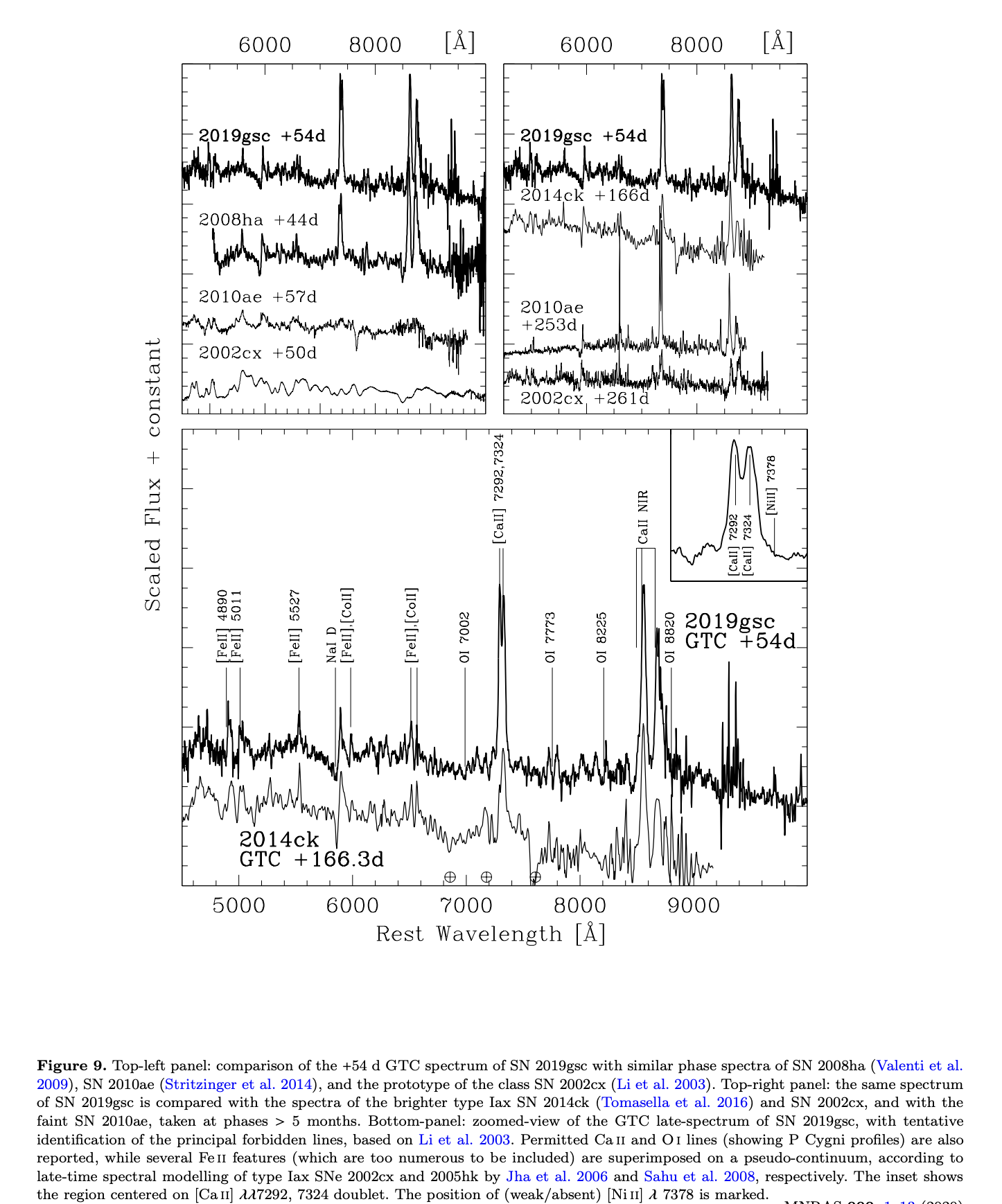Padova-Asiago Supernova Group
Highlights
Observations of the low-luminosity Type Iax supernova 2019gsc: a fainter clone of SN 2008ha ?
Tomasella, L. et al. 2020 MNRAS in Press (arXiv:2002.00393v2) (link to pdf)
We present optical photometric and spectroscopic observations of the faint-and-fast evolving type Iax SN 2019gsc, extending from the time of g-band maximum until about fifty days post maximum, when the object faded to an apparent r-band magnitude mr = 22.48+/-0.11 mag. SN 2019gsc reached a peak luminosity of only Mg = -13.58+/-0.15 mag, and is characterised with a post-maximum decline rate Dm15(g) = 1.08+/-0.14 mag. These light curve parameters are comparable to those measured for SN 2008ha of Mg = -13.89+/-0.14 mag at peak and Dm15(g) = 1.80 +/- 0.03 mag. The spectral features of SN 2019gsc also resemble those of SN 2008ha at similar phases. This includes both the extremely low ejecta velocity at maximum, ~3,000 km/s , and at late-time (phase +54 d) strong forbidden iron and cobalt lines as well as both forbidden and permitted calcium features. Furthermore, akin to SN 2008ha, the bolometric light curve of SN 2019gsc is consistent with the production of ~0.003+/- 0.001 M sun of 56Ni. The explosion parameters, Mej ~0.13 Msun and Ek ~ 12 x 10^48 erg, are also similar to those inferred for SN 2008ha. We estimate a sub-solar oxygen abundance for the host galaxy of SN 2019gsc (12 + log10(O/H) = 8.10 +/- 0.18 dex), consistent with the equally metal-poor environment of SN 2008ha. Altogether, our dataset for SN 2019gsc indicates that this is a member of a small but growing group of extreme SN Iax that includes SN 2008ha and SN 2010ae. 220
Tomasella, L. et al. 2020 MNRAS in Press (arXiv:2002.00393v2) (link to pdf)
We present optical photometric and spectroscopic observations of the faint-and-fast evolving type Iax SN 2019gsc, extending from the time of g-band maximum until about fifty days post maximum, when the object faded to an apparent r-band magnitude mr = 22.48+/-0.11 mag. SN 2019gsc reached a peak luminosity of only Mg = -13.58+/-0.15 mag, and is characterised with a post-maximum decline rate Dm15(g) = 1.08+/-0.14 mag. These light curve parameters are comparable to those measured for SN 2008ha of Mg = -13.89+/-0.14 mag at peak and Dm15(g) = 1.80 +/- 0.03 mag. The spectral features of SN 2019gsc also resemble those of SN 2008ha at similar phases. This includes both the extremely low ejecta velocity at maximum, ~3,000 km/s , and at late-time (phase +54 d) strong forbidden iron and cobalt lines as well as both forbidden and permitted calcium features. Furthermore, akin to SN 2008ha, the bolometric light curve of SN 2019gsc is consistent with the production of ~0.003+/- 0.001 M sun of 56Ni. The explosion parameters, Mej ~0.13 Msun and Ek ~ 12 x 10^48 erg, are also similar to those inferred for SN 2008ha. We estimate a sub-solar oxygen abundance for the host galaxy of SN 2019gsc (12 + log10(O/H) = 8.10 +/- 0.18 dex), consistent with the equally metal-poor environment of SN 2008ha. Altogether, our dataset for SN 2019gsc indicates that this is a member of a small but growing group of extreme SN Iax that includes SN 2008ha and SN 2010ae. 220
